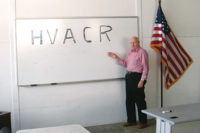
Instead, students eagerly interact with a touch screen menu to call up "vital signs" screens to see which grade is winning the ongoing monthly energy conservation contest. Or, they might monitor the effects the previous night's rainfall had on replenishing the school's rainwater collection system. Or, they might call up a vital signs screen that shows the dollar savings in energy and the pounds of power plant CO2 emissions that the school has saved through its innovative daylighting and solar PV systems.
Then, throughout the rest of the day, the students continuously refer to vital signs screens as they relate to the curriculum being taught in each class. In science, for example, they might use a "daylighting" screen to learn how the angle of the sun changes throughout the course of the year. In math, students can interact with vital signs to calculate how a 1-inch rainfall equates to hundreds of gallons of water harvested from the building's roof for low-flow toilets, urinals, and other "grey water" uses.
"Twenhofel is unique in that the building itself has been designed to serve as a teaching tool, where students can see how a building functions and the enormous effect they have as occupants on its performance," said Robert Lape, facilities director for the Kenton County schools system, one of the largest in Kentucky.
"We call it a high-performance school, where students can excel through an enhanced environment - while at the same time reducing the total energy and lifecycle costs to the school district."
CHECKING THE VITALS
The vital signs capability is just one of the school's many features designed to earn rating points with the United States Green Building Council's (USGBC's) Leadership in Energy and Environmental Design (LEED) system.In the case of Twenhofel, the building has been designed to earn anywhere from 33 to 38 points on the LEED certification scale, ultimately qualifying the school as Kentucky's first LEED Silver certified school.
Innovative Energy Solutions (IES), of Hamilton, Ohio, was selected as the systems integrator for the project, responsible for designing and integrating the school's advanced Invensys I/A Series® energy management and control system, and for the cre-ation of the vital signs screens.
"With the features of the I/A Series system, we're able to precisely monitor, control, and measure the effects and benefits of all the unique systems incorporated into this project," said John Brofft, vice president, sales manager for IES.
As an example, the daylighting system in each classroom uses photocells, which measure the light in foot-candle levels and then activate artificial lighting only when natural light isn't sufficient, he explained.
According to Brofft, several photocells communicate over a LonWorks network to the Invensys control system, while Modbus power monitors throughout the building measure the building's electrical usage to validate the effects of the daylighting system.
The architects (Robert E. Hayes & Assoc.) designed the building with a north/south exposure, and equipped it with daylighting baffles, to allow the optimum level of natural light into classrooms through clerestory windows, such that upwards of 70 percent of the annual required light is provided naturally, said Brofft. This combination of innovative design and precise control typifies the school, and will ultimately result in significant energy savings, he said.

100 PERCENT SUSTAINABLE
In fact, overall energy consumption for the 111,000-square-foot building is expected to be at least 30 percent less than a comparably sized conventional school building, thanks to the use of sustainable geothermal energy sources for 100 percent of the school's HVAC needs.According to Brofft, there is also innovative heat recovery systems designed to minimize the heat that is normally lost from outside air-handling units. The geothermal field, consisting of miles of tubing and thousands of gallons of water for heat rejection and reclaim, is located some 300 feet below the surface of the sports stadium.
"The use of a geothermal heat pump system to transfer heat to and from the school marks a radical departure from conventional blowers and chiller units, allowing us to achieve considerable energy savings and also better control IAQ, which is a big LEED emphasis," said Tony Hans, design engineer for CMTA Engineering Consultants (Louisville, Ky.), the firm that designed the geothermal system.
"Twenhofel is a shining example of how innovative building design and energy management systems can work together to enhance student and teacher performance," concluded Dr. Susan Cook, superintendent of Kenton County Schools.
Publication date: 03/27/2006


